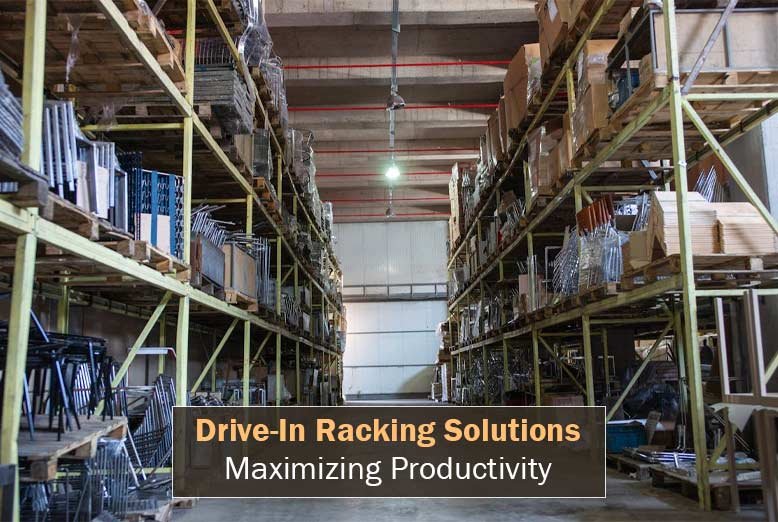Key Highlights
- Drive-in racking is a high-density storage solution that maximizes space utilization by reducing aisle space.
- It’s ideal for storing large quantities of homogeneous products with low turnover rates.
- This system enhances warehouse efficiency by improving storage capacity and streamlining pallet access.
- Proper implementation involves design considerations, optimized pallet loading processes, and rigorous safety protocols.
- Drive-in racking is particularly beneficial for cold storage facilities where space optimization is critical.
Introduction
Photo by Engin Akyurt: https://www.pexels.com/photo/green-metal-shelves-with-construction-materials-4170172/
In today’s competitive market, boosting warehousing warehouse productivity is key to success. Drive-in racking is a smart storage solution. It helps use available space better and makes operations run smoother. This system allows businesses to store a large number of pallets while taking up less aisle space. As a result, it increases storage capacity and helps improve workflow. This article will show how drive-in racking systems can change your warehousing operations and raise productivity.
Enhancing Warehouse Efficiency with Drive-In Racking Systems
Photo by Antonius Natan: https://www.pexels.com/photo/a-supermarket-with-and-industrial-interior-11835351/
Warehouse organization and efficiency are very important today in Melbourne. Businesses need to improve their storage solutions to keep up with market demands. Drive-in racking systems are a great way to boost efficiency and productivity in warehouses.
Unlike conventional pallet racking, which needs aisles for forklift access, drive-in racking lets forklifts go into the racking area to load or take out pallets. This setup cuts down on the need for many aisles. It is a very effective storage solution, especially for companies that handle large quantities of similar products.
Understanding the Basics of Drive-In Racking
Drive-in racking is a special type of pallet racking system made for storing a lot of SKUs in a small space. In this system, pallets are set up so forklifts can go inside the racking. This helps to use storage space well and reduces the need for wide access paths like in other systems.
Unlike selective pallet racking, where each pallet can be reached easily, drive-in racking focuses more on how tightly items can be stored, making it great for businesses that handle high pallet quantities and large quantities of the same or similar products.
The system works on a “last in, first out” (LIFO) method. This means the last unit load placed in the rack is the first one taken out. While this may not fit all warehouse needs, it works well for businesses with products that don’t expire quickly or that have a specific way they need to be rotated.
Key Benefits Drive-In Racking Offers for High-Density Storage
Choosing the right storage system is very important for improving how a warehouse works. For businesses that handle a lot of similar products, using a drive-in racking system can be very helpful. This high-density storage solution can save aisle space and use vertical space to greatly increase storage capacity, especially for fragile product loads compared to regular pallet racking.
This storage system is great for businesses with seasonal items, bulk storage needs, or large amounts of a few product types. It is also very useful for cold stores because keeping the right temperature is vital. Plus, it helps make the most of the storage space, which can save on energy costs.
Here are some important reasons why drive-in racking is seen as a great high-density storage solution:
- Increased storage capacity: It reduces aisle space, allowing you to store many more pallets.
- Cost-effective: It helps you use your current space better, which can lessen the need to expand the warehouse.
- Improved organization: Drive-in racking makes inventory management simpler.
Implementing Drive-In Racking for Optimal Productivity
To successfully set up a drive-in racking system, you need to plan carefully. This means thinking about different factors. You want it to fit well with your current warehouse layout and operations to get the most benefits.
Start by figuring out your storage needs. Look at the types of products you handle. Also, consider things like the building height and how easy it is for forklifts to access the area. Each of these details is key to making the system work better and ensuring you get your money’s worth.
Essential Design Considerations for Drive-In Rack Layout
When designing the drive-in rack layout, careful consideration should be given to the following factors:
Building Dimensions: Assessing the warehouse’s maximum height and available floor space is crucial to determining the rack’s dimensions and configuration.
Product Characteristics: Evaluating the size, weight, and stacking limitations of your products is vital for choosing appropriate horizontal profiles and determining lane depth.
Accessibility Requirements: Ensure sufficient space for forklifts to maneuver within the system. Consider aisle width, turning radius, and clearance heights:
| Feature | Consideration |
| Aisle Width | Sufficient for safe forklift operation |
| Turning Radius | Accommodate forklift maneuverability |
| Clearance Heights | Allow for pallet lifting and stacking at maximum height |
Optimizing Pallet Loading and Retrieval Processes
Efficient pallet loading and retrieval are very important to boosting productivity with drive-in racking. A clear process helps to reduce handling time and makes good use of forklift trucks.
Most drive-in racking systems follow the Last-In, First-Out (LIFO) method. However, some can also be set up for First-In, First-Out (FIFO) if needed. Knowing how often your products move and how you need to handle stock will help you find the best loading and retrieval method.
It is important to have clear and open access aisle space. Good lighting is necessary for safe forklift operation. This helps to lower the accident rate and ensures that pallets are placed and taken out correctly. Train forklift operators to follow the right steps when moving and handling pallets in the drive-in racking system.
Best Practices for Maintaining Drive-In Racking Systems
Photo by Tima Miroshnichenko: https://www.pexels.com/photo/man-in-black-button-up-shirt-standing-beside-man-in-gray-polo-shirt-6169650/
Keeping your drive-in racking system safe and sturdy is very important. It helps it last longer and protects your warehouse workers. To do this, you need to inspect it regularly, perform maintenance, and follow safety rules. This way, the system works well and accidents are less likely to happen.
Having a maintenance schedule can help spot problems early before they get worse. By checking the parts often, you can replace any damaged pieces in time. This helps avoid expensive breakdowns and keeps the work environment safe.
Routine Inspection and Maintenance Tips
A regular inspection routine will help spot and fix problems before they turn into big issues. This will help your system last longer.
- Visual Inspection: Check the support rails, upright protectors, and bracing often. Look for damage like bends, dents, or rust. Make sure safety clips are not missing or broken and replace them right away.
- Load Capacity Checks: Make sure the racking system is not too heavy. Show the load capacity for each level clearly. Train your staff to know and follow these limits.
- Professional Inspection: While doing in-house checks is important, think about getting a professional inspection once a year or every six months. Experts can find small signs of wear that you might miss. They will also give you advice on repairs or changes needed.
Safety Measures to Prevent Accidents and Damage
Implementing safety measures is very important when using a drive-in racking system. The tight space and special handling needs require extra care. This helps stop accidents and reduces the chance of damage to both the system and the stored products.
- Forklift Training: Only trained and authorized people should use forklifts in the racking system. It is important to give enough training on safer handling and the right way to move within the drive-in system.
- Speed Limits: Set strict speed limits in the racking system. High speeds can cause crashes and increase the chance of pallet damage or collapse.
Load Capacity Monitoring and Enforcement
Maintaining the load capacity of your racking system is very important. It helps keep the system strong and ensures the safety of everyone in the warehouse. Each part, from the upright frames to the support beams, can handle a certain weight. If you go over this limit, it can cause serious problems.
Using signs is a great way to enforce load limits. Put up clear signs at the end of each row to show the maximum load capacity for each level. Mark empty rack locations to help forklift operators. This can stop them from accidentally overloading some areas.
Make sure to check the load capacity information regularly and update it if needed. If you change your racking configuration, like adding new levels or changing the layout, update the load capacity calculations. Be sure to let all relevant staff know about these changes.
Regular Cleaning and Debris Removal
Maintaining a clean and organized space around your drive-in racking system is important. It helps with warehouse safety and how well things operate. Cleaning regularly and removing clutter can prevent accidents, help people see better, and keep your system working longer.
Make sure the floor level is free of obstacles. Extra pallets, packing materials, or dust can be dangerous for forklift operators. They can cause trips or make surfaces uneven, which might lead to pallet misalignment or tipping.
Set up regular cleaning times as part of your warehouse care plan. Promote good habits among your warehouse workers. Stress the need to report spills quickly, clean up loose packaging, and keep the work area tidy.
Proper Training for Forklift Operators
Proper training for forklift operators is very important when using a drive-in racking system. The training should cover the unique challenges and safety rules that come with this type of storage system. It should focus on both theory and hands-on skills.
More than just basic forklift training, drivers need special lessons on moving in the racking aisles. They should learn to keep safe speeds, know clearance heights, and make tight turns carefully in the limited space of the drive-in system.
Regular refresher courses must be a requirement. These courses will strengthen safe handling practices, share new safety rules, and talk about any problems or near-misses faced in the warehouse.
Photo by Tiger Lily: https://www.pexels.com/photo/warehouse-workers-standing-in-corridor-4484073/
Conclusion
In conclusion, using drive-in racking systems can improve how your warehouse works. If you know the basics and focus on loading tasks and maintenance, you can get the most out of your storage solutions. It’s important to keep safety in mind, check things regularly, and make sure forklift operators are trained well. With drive-in racking, you can store pallets better, use your space wisely, and increase productivity in your warehouse. Want to make your storage even better? Contact us today for a consultation that fits your warehouse needs.
Frequently Asked Questions
What Makes Drive-In Racking Suitable for High-Density Storage?
Its design allows it to hold a large number of pallets while using the available space efficiently. Drive-in systems reduce the need for single-aisle and make the most of vertical storage. This feature is great for cold stores where it is key to maximize space. Though it may limit selectivity, it is very good at storing large volumes of similar products.
What is drive-in racking and how does it differ from other storage systems?
Drive-in racking is a type of deep pallet racking system. Forklifts can go into the racking to store and get pallets. This makes it great for storing a lot of items in a small space. Unlike selective pallet racking, Bowen Storage drive-in racking gives users direct access to all pallets, but it holds fewer items. Drive-in racking works on a LIFO method, meaning the last pallet put in is the first one taken out. On the other hand, a system like Drive-Through racking can use FIFO, where the first pallet in is the first out if needed.
Also Read: How Can Modular Storage Systems Improve Productivity In Logistics?















